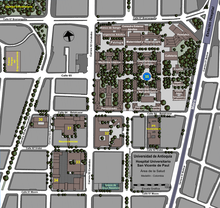Manzana (unit)
The dictionary of the Spanish language of the Spanish Royal Academy, the authoritative source for the Spanish language, defines the word manzana (in addition to its unrelated meaning as "apple") as "urban space, built-up or intended to be built up, usually quadrilateral in shape, delimited by streets on all sides". There is no mention of the term as being a unit of area.[1]
A manzana is a unit of area used in Argentina and in many Central American countries, originally defined as 10,000 square varas in Spanish customary units.

Today its size varies between countries:
- In Argentina it is a hectare, 10,000 m2.
- In most Central American countries it is about 7,000 m2 (1.7 acres), varying between countries.
- In Belize it is 8,353 m2 (2.064 acres).
- In Nicaragua it is 7,042.25 m2 (1.74018 acres).
If a vara is taken as 83.59 cm, then a manzana of 10,000 square varas is equal to 6,987.29 m2. In calculations, the approximate value of 7000 m2 (or equivalently 0.7 ha) is often used to simplify conversion.
See also[]
Footnotes[]
- ^ While this map is not drawn to scale, the distribution and volume are consistent with the shape of the manzanas and buildings and the graphic scale is intuitively drawn based on the geography.
References[]
External links[]
- manzana definition on sizes.com
- Rowlett, Russ (2018). "How Many? A Dictionary of Units of Measurement". ibiblio. University of North Carolina at Chapel Hill. Retrieved 24 March 2020.
- Units of area
- Standards and measurement stubs